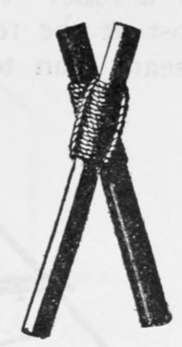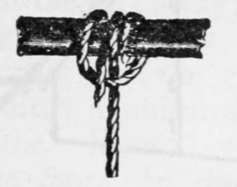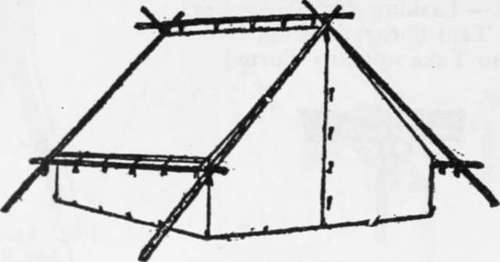Tint On Shears
Description
This section is from the book "Camping And Woodcraft", by Horace Kephart. Also available from Amazon: Camping and Woodcraft.
Tint On Shears
Tent poles are bothersome on the train and in a wagon, and impossible in a canoe or on a pack train unless they are jointed. Socketed poles become useless, or hard to refit, if a ferrule is stepped on or otherwise dented. An upright pole in the doorway must be dodged every time you go in or out. A pair of shear legs at each end of the tent, to support the ridge pole, is a stancher set.
Cut four straight poles a couple of feet longer than the distance from peak to corner of tent, and a stiff stick for ridge pole about two feet longer than the tent. To bind the shear poles, lay a pair ot them side by side; with a small rope take several turns around both poles near their upper ends, not too tightly, then pass the ends of the rope one up and the other down, to form a cross-lashing, and tie them with a reef knot (Fig. 12). When the butts of the shear legs are drawn apart the crossing of the tips puts a strain on the knot and effectually secures them (Fig. 13).

Fig. 12. Lashing for Shear Legs. (For Tent Shears it is not Necessary to Take so many Turns).

Fig. 13. Shea Legs Spread.

Fig. 14. Magnus Hitch. (Not Apt to Slip Along a Pole).
Having spread out the tent and inserted the ridge pole (or tied it outside), raise tent with the shears, and spread their legs until the tent just touches the ground when ready to be pegged down (Fig. n). One man can raise a rather heavy tent in this way by working first at one end and then at the other.
In the case of a wall tent with fly, erect side frames for the guys (Fig. n) ; but if no fly is used, all that is needed is to lash side poles to the shears and tie the eaves fast to them: this is the best rig for a small waterproof tent that is to be moved often (Fig. 15).
Sometimes the rear end of the ridge pole can be lashed to a convenient sapling, or rested in the fork of a limb. Some campers plant a single crotched post at the rear, but usually it is easier to set up shears than to find a suitable crotch and plant it firmly. It is one advantage of shear legs that they can be erected without difficulty anywhere, although the ground may be rocky or frozen.

Fig. 15. Wall Tent with Side Bars.
This rig has several other merits. It leaves the doorway unobstructed. The legs do not sink so much in soft soil or sand as single uprights; if they should sink, they can be raised in a trice by drawing the butts closer together. Similarly, when the tent shrinks, from wetting, the strain can be eased by simply lifting one shear leg and pushing it a little farther outward. When the canvas sags, draw the legs closer to their mates, and you stretch the tent as taut as a drum-head.
An inside ridge pole is best for a large, heavy tent; but it must be straight and smooth, or it will wear the canvas and make it leak. Small or medium-size tents are best made with a strongly reinforced outer ridge with cords by which the tent is tied to an outside ridge pole (Fig. n). In this case the pole need not be so straight nor so carefully trimmed.
An outside ridge pole is excellent to keep a tent fly clear all around from the tent roof, permitting a free circulation of air between the two, which keeps the tent cool in summer.
Continue to:
